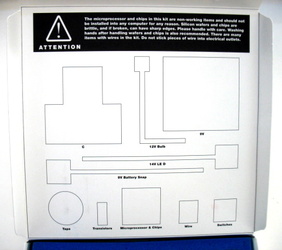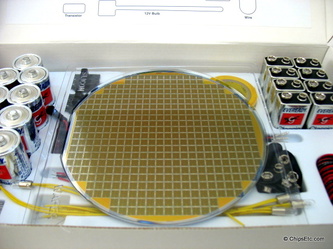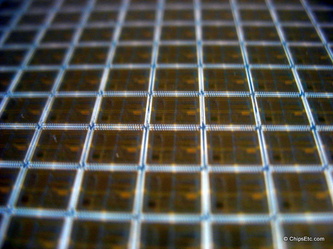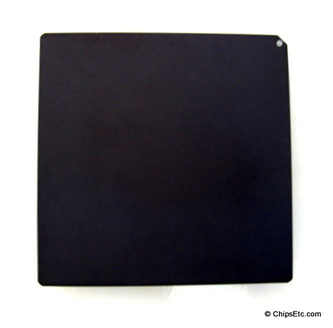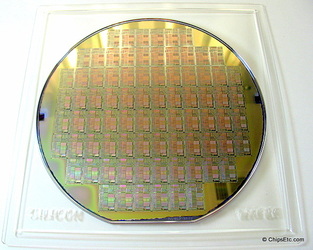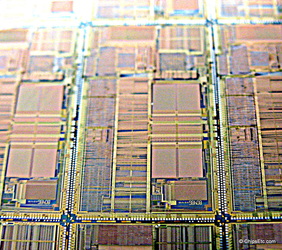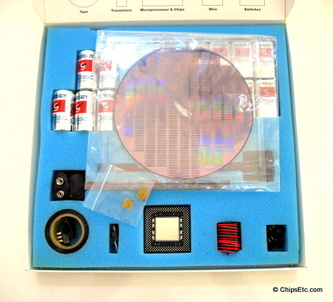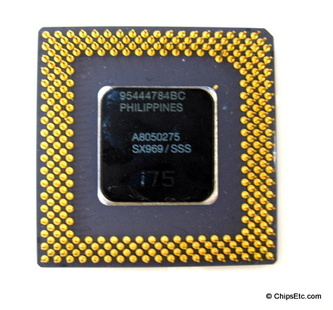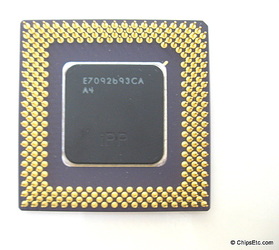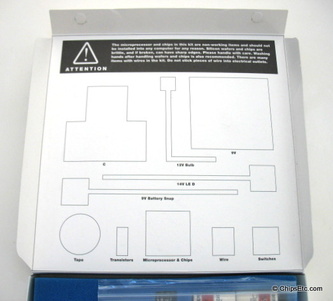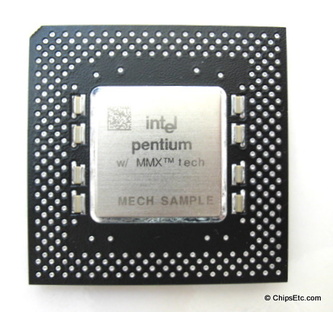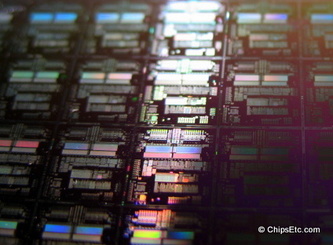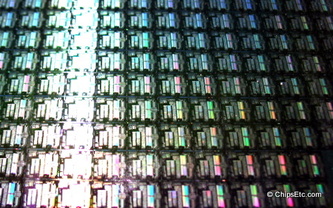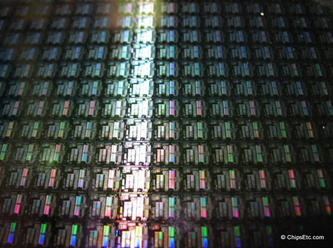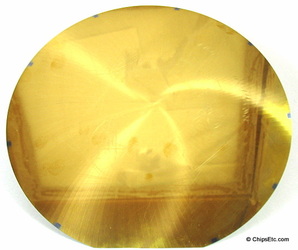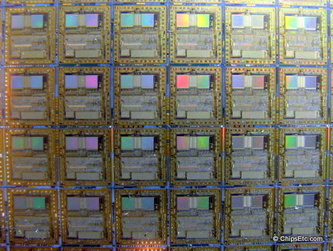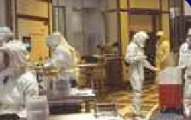First distributed to teachers in the United States and Canada in 1994, 35,000 free kits were delivered to science departments in junior high and middle schools, they were designed to expose kids to the technology and science behind the computer revolution, Intel valued this kit and its rare components at $500. The kits were created in consultation with the National Science Teachers Association.
The Journey Inside Educational Program consists of three components. There is a teachers guide (including handouts and overheads) and a teachers video. A classroom video includes 8 different 8-10 minute lessons. And there is a hands-on kit, allowing students to build circuits and begin to get a hands-on understanding of the basics of computer technology. All the parts required for the electronics projects are included: switches, LED lights, transistors. This is one kit where batteries are definitely included; seemingly enough batteries to outfit a Radio Shack outlet. In addition, (my favorite) there's a collection of actual computer elements in the package; a real Pentium chip, and even a 6" (150mm) silicon wafer, and two loose diced (separated from wafer) chips. (These are parts that failed the reliability tests, but are valuable in letting teachers and students get their hands on the real thing, helping to make computers less mysterious).
The lessons were very well designed, each included a basic lesson, and a more advanced extension lesson, allowing teachers to easily adapt the material to the level of their students. Each lesson was designed to take about a half hour of classroom time. The package starts off with an introduction to computers, then looks at circuits and switches as the basis of computing. It continues by introducing the important concept of digital information, leading to an examination of microprocessors, and how chips are created. Finally, it moves on to examine networks, look at the impact of technology on society, and ends with a view of the future.
The learning kits are no longer being made. Intel does offer the student curriculum online.
Components of the Intel Chip Kits

To complete the experiments described in the teacher's guide, the chip kit includes an actual 6" (150mm) Intel silicon wafer, a non-working packaged microprocessor (often this is a Pentium Mechanical Sample CPU), loose processor chips (diced chips), transistors, diodes, connecting wires, and batteries for use in hands-on study lessons.
The Intel Chip kits in our collection
Intel Teaching Kit 2nd Edition (1996)

Intel Journey Inside Chip Kit 2nd Edition (1996)

Also included are singulated Intel Pentium & 486 CPU dies.
The Journey Inside Program Kit (1998)

The Journey Inside Program Kit (1998)
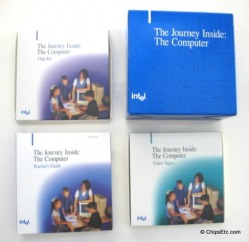
The Journey Inside Program Kit (1998)

The Journey Inside Program Kit (1998)

In October 1996 Intel released the 4th Pentium generation as the 'Pentium with MMX Technology' (usually just called Pentium MMX); it was based on the standard Pentium core, the 0.35 µm process of 3rd generation Pentiums was also used to manufacture this series, but it had a new set of 57 "MMX" (MultiMedia eXtensions) instructions.
The Journey Inside Program Kit (1998)

The Journey Inside Program Kit (1998)

The Journey Inside Program Kit (1998)

Intel Pentium P5 Processor Wafer (1993)

The backside of the wafer is gold. This wafer has no reject "dot" marks on any of the 42 processors so it is unknown if it was ever tested/sorted.
Item was featured in the The "Intel - Innovations in Arizona" exhibit at the Arizona Science Center in 2014.
Intel Silicon wafer (1998)

About the Intel "Journey Inside" Chip kits
This was a product designed by Intel and offered free to educators. The "Journey Inside: The Computer Kit" includes a teacher's video tape giving suggestions for teaching, a student video that through teenagers as presenters brings the concept of how a computer works to students in a meaningful way, various pieces of equipment - as an actual silicon wafer, a non-working packaged microprocessor, loose processor chips, transistors, diodes, connecting wires and batteries for hands-on study, and 8 lessons and activities for students to accomplish electrical and other activities. Although the kit is aimed for grades 5 - 9, there still are components you may want to use, especially if electricity is not taught in your school. The kit allows students to see computer transistors at work as they create direct current circuits. ...And students easily understand more about computers after watching the video.
The chapters covered are:
- Introduction to Computers
- Circuits and Switches
- Digital Information
- Microprocessors
- Creating Chips
- Networking
- Technology and Society
- What's Next?
"The Journey Inside Program"
Where Education and Adventure Meet Head On ... Inside the Computer
Intel press release, 1994
Intel Corporation has launched a national education program designed to
increase technology literacy among students and inspire them to learn more
about the science behind computer technology. "The Journey Inside"
technology education program is aimed specifically at grades five
through nine when a students' interest in science, math and related studies
can really take hold.
Computer Technology Education Kit
Our free comprehensive classroom kit, The Journey Inside: The Computer,
comes in a package that is a learning tool itself -- the box serves as a
model of a personal computer for students to open up and examine. The kit
contains a teacher's guide, video, poster, and hands-on chip kit.
The 300-page teacher's guide includes background information, lesson plans,
student materials, overheads and vocabulary for six units which are divided
into beginning, intermediate and advanced levels. The units cover the basic
operations of computers and microprocessors, digital information,
transistors, chip manufacturing and a review of critical inventions
throughout history.
The six-module video introduces the concepts of each study unit with a
typical twelve-year-old on a quest to learn more about computers. The poster
reinforces key concepts from the video.
To complete the experiments described in the teacher's guide, the chip kit
includes an actual silicon wafer, a non-working packaged microprocessor,
loose processor chips, transistors, diodes, connecting wires and batteries
for hands-on study.
The raw material for the program was developed by a collaborative of nine
science teachers under the direction of Penny Moore, U.C. Berkeley, director
of Prime Science and Science for Science Teachers. The materials have been
refined for classroom use by the International Society for Technology in
Education, who also conducts training classes for teachers in the effective
use of the kit.
Beyond the Classroom
Where available, teachers can take their classes to see Intel's companion
IMAX film, The Journey Inside: A Learning Adventure in High Technology. This
is the first IMAX film made primarily for children, the first to use a
science-fiction story to communicate information, and the first to
introduce viewers to the amazing microscopic world of computer chip
technology. The film follows twelve-year-old Jimmy on his race to foil an
alien plot to slow the advancement of technology on earth. Along the way, he
learns how computer chips are made.
To amplify the technical concepts presented in the film, Intel created four
museum-quality exhibits for the theater lobbies. These describe the major
functional areas of a microprocessor, the layering process by which chips
are made, the clean room environment where chips are made and the basic
operations of a personal computer.
Teachers scheduling field trips to the film will receive a 20-page
Teacher's Activity Guide with pre-film discussion points and vocabulary, and
a series of post-film activities that review key concepts from the film. The
film is scheduled to appear at several IMAX theaters worldwide, or contact
your local IMAX theater for future availability.
"The Journey Inside" kits are available free of charge to qualified
teachers in the United States and Canada. Qualified teachers are those
teaching science, math or computers in grades five through nine.
"The Journey Inside" - Intel / IMAX Movie
"The Journey Inside" VHS Movie (1994)

ASIN: B0014PKFVO
Directed by Barnaby Jackson and produced by Adam Moos
VHS - 40 mins. length
"Take a guided tour through the super-clean world of a high-tech computer chip factory. Explore the world inside the computer. And hold on to your seat for a thrill ride through the heart of a microprocessor. This unusual experience is waiting for you in The Journey Inside. This family learning adventure follows 12 year-old Jimmy on his race to foil an alien plot to slow the advancement of technology on Earth. Along the way, you and Jimmy will learn how computer chips are made and be introduced to the amazing microscopic world of computer chip technology. You won't want to miss it."
Intel "The Journey Inside" Holographic Chip (1994)

Comes new in gift box.
VIDEO: Intel Journey Inside the Computer (1994)
"Intel goes to the Movies"
Variety Magazine Review, May 1994
For one thing, though the film is educational, it features a narrative plot, something not usually found in the IMAX format. IMAX films are often referred to as "destination" films; in other words, the viewer travels to a specific place, such as the Grand Canyon or the Brazilian Rain Forest, sans plot.
"The Journey Inside," on the other hand, is an action-adventure story about a young boy who goes up against aliens. Not forgetting its educational roots, however, the film does attempt to teach us how computer chips are made and used.
"The film was a true test of this medium," said Jackson, whose company, Rocket Motion Pictures, is currently producing "Endless Summer: The Ride," which will be released concurrently with New Line's bow of the feature film sequel this summer. It was Jackson who suggested the sci-fi theme of the movie. "With the use of large scale sets and action sequences, the Imax technology was pushed to the edge, but never failed," he explained.
Another interesting angle is that the film, whose production was coordinated by Dick Clark Corporate Productions and shot at Hollywood-based Raleigh Studios, utilized the talents of many top-notch Hollywood pros, including cinematographer John Hora, editor William Goldenberg, special effects supervisor Peter Anderson and composer David Shire, in addition to effects house Dream Quest Images, IMAGE G and Metrolight Studios.
"Everyone was eager to work in IMAX," Intel's Dana Houghton said. "There's a growing recognition that these alternative formats are viable and the projects are attracting Hollywood talent."
Houghton, who runs the company's IDEA (Intel Digital Education and Arts) program, hatched the idea of Intel getting behind this type of film, and said the company was looking for a way to make people comfortable with technology, but in an entertaining way.
"If you look at research on penetration on personal computers, more people don't use them than do use them," says Houghton. "This will prepare the public to consume technological products. We can effect that part of that equation."








